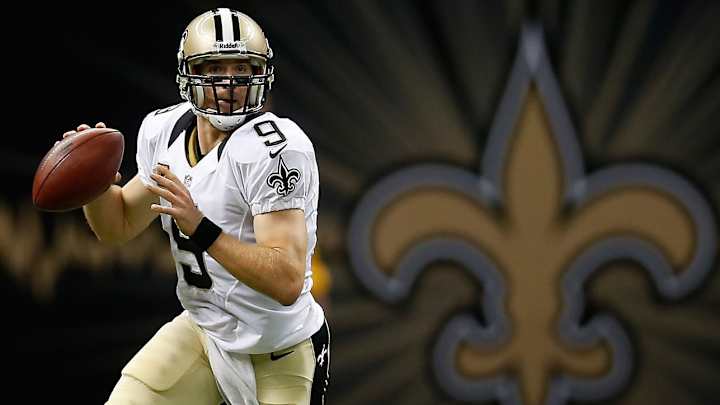New Orleans Saints: 10 Things You Need to Know

1. It’s never good when an offense is without its starting left tackle (Terron Armstead) and center (Max Unger). As is the case with most offenses, these are the two most important players along New Orleans’s O-line. But their early season absence can be overcome with Drew Brees at the helm. Brees, with his brilliant pocket movement and nearly perfect field-reading efficiency, has always hidden flaws along his front five. In fact, in the first half of last season, the Saints were in utter turmoil on the left side, but you would have never known it.
2. Another reason the Saints’ O-line can survive with backups is their scheme naturally helps the offensive tackles. For one, no team in the NFC played with six offensive linemen more last year than the Saints. Sean Payton loves to throw out of a 6-OL grouping. For two, the Saints often have tight ends and running backs chip-block. This prevents those guys from getting into their routes quickly, but that’s fine because they’re often underneath checkdown options anyway. Brees’s eyes don’t reach them until late in the play.
Chicago Bears: 10 Things You Need to Know
3.For years, Marques Colston made a career on seam routes, where he’d defeat linebackers and safeties with high-point catches while on the move. The Saints haven’t found their new Colston yet. Second-year receiver Michael Thomas has size and is deliberate in the mechanics of his route running. But so far he’s been more of an in-breaking route possession receiver, which means he aligns wide, not in the slot. Tight end Coby Fleener has the frame to work the seams, but he is far too unreliable on contested catches and often ineffective as a blocker, which can limit his snaps. The guess here is that 5’11” Willie Snead will continue to be the slot receiver. He’s a prototype (and a productive one), but not a natural seam weapon. Tactically, it’s a different Saints offense without a Colston-type weapon.
L.A. Rams Preview: 10 Things You Need to Know
4. Don’t be surprised when Adrian Peterson supplants Mark Ingram in the running back pecking order. Peterson fits the nature of New Orleans’s north/south ground game.
Buffalo Bills Preview: 10 Things You Need to Know
5. The Saints have been bad defensively, but it’s not for lack of trying in the front office. They have spent two of their top three draft picks on defense each year since 2011 and they’ve made moves in free agency. The wet-noodle-to-wall approach has left them with a ton of depth this year . . . if we’re considering depth to be “young, higher-drafted players who could possibly carve out significant roles in 2017 but also might be nothing.” Only five of New Orleans’s starters are proven and 100% locked in: defensive end Cameron Jordan, defensive tackle Sheldon Rankins, cornerback Delvin Breaux, and safeties Kenny Vaccaro and Vonn Bell. That’s not to say the other positions are in dire straits. They’re just unsettled.
6. Linebacker could be a strong group if Craig Robertson defends the run as adeptly as he did last year and A.J. Klein shows the play-recognition in this scheme that he had in Carolina’s.
San Francisco 49ers Preview: 10 Things You Need To Know
7. Defensive coordinator Dennis Allen loves to be deceptive and diverse in his scheme. He was this way as the Raiders’ head coach, too. You see a ton of different personnel groupings, front seven alignments and coverage rotations from Allen’s unit. It’s no surprise the Saints drafted a man coverage corner, Marshon Lattimore, in the first round. The better in solo coverage your corners are, the more expansive your scheme can be.
Cleveland Browns Preview: 10 Things You Need to Know
8. Another propagator of an expansive scheme is versatility at the safety position. By drafting free safety Marcus Williams in the second round, the Saints found a replacement for their most inconsistent starter last year, Jairus Byrd—plus now they can play both Kenny Vaccaro and Vonn Bell (last year’s second-rounder) near the box. Both men are quick-closing tacklers and have man-coverage abilities. Most likely, the Saints will be a big nickel-base defense (just like last season). That means playing with two linebackers and three safeties.
New York Jets Preview: 10 Things You Need to Know
9. In passing situations, expect Allen to play dime (six defensive backs), which is also something he did in 2016. As part of his disguise-tendencies, Allen likes to blitz defenders from 10 yards back or farther. Almost never are those defenders accounted for in an offense’s pass protection rules. A deep blitzer like this must be fast enough to cover the extra ground. Playing safeties instead of linebackers puts that speed on the field.
10. Defensive end Cameron Jordan is not a twitchy or explosive edge rusher, but there aren’t many finer football players than the seventh-year pro. Jordan’s technique is tremendous, both on individual moves and in multi-defender concepts, like stunts, twists and D-line slants. He wears opponents down over the course of longer pass plays and stands out every week in run defense (his 17 TFLs last year tied for the league lead).
Question? Comment? Story idea? Let us know at talkback@themmqb.com
